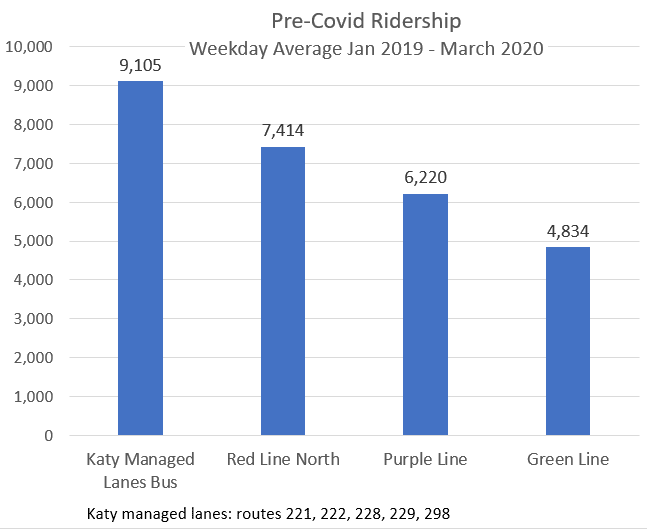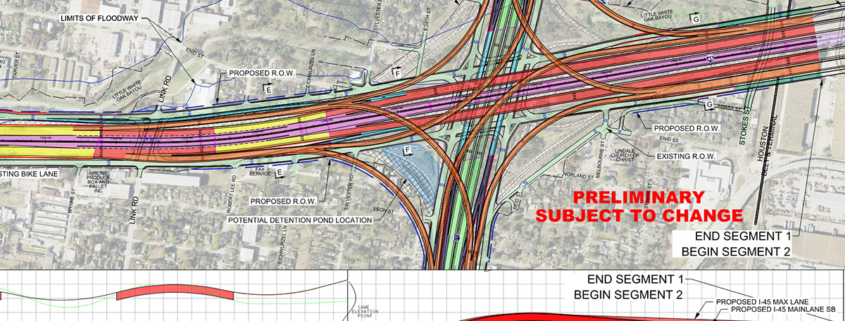What the Katy Managed Lanes Tell Us About the NHHIP 45N Expansion
This week we have a great guest post on the effectiveness of managed lanes and why they’re so critical to the 45N expansion plan from Oscar Slotboom, author of Houston Freeways. (highlights mine)
Managed lanes are one of the more controversial features in the North Houston Highway Improvement Project. The current HOV lane uses 25 feet of width in the center of the existing freeway where there are no interior shoulders, and 41 feet of width where there are interior shoulders. In the NHHIP design, the managed lanes require 82 feet and the interior shoulders (with pylons) require 25 feet, for a total of 107 feet. So the extra width required for the managed lanes is 66 to 82 feet, which is about 37% of the needed new right-of-way north of Loop 610. The rest of the needed right-of-way is for buffers outside the frontage roads (27 feet on each side), wider frontage roads including a 15-foot-wide shared lane, more space between the main lanes and frontage roads, and auxiliary (merging) lanes for the main lanes.
The City of Houston proposal, which is endorsed by Harris County, would remove the managed lanes entirely and also remove the existing reversible HOV lane. Other opposition groups want more public transit emphasis and no right-of-way acquisition which would eliminate the managed lanes.
Of course, we already have a managed lane facility in Houston, the Katy Managed Lanes. Let’s take a closer look at its performance, before and after Covid. Data sources: Metro and HCTRA.
Attention NNHIP Opposition: Managed lanes have demonstrated substantial transit ridership
In 2019, prior to Covid, Metro’s bus routes using the Katy Managed Lanes served 9,105 weekday public transit trips, more than the $756 million Red Line north extension and the Green or Purple Lines, which together cost $1.4 billion. The original Red Line, which has strong ridership, had 42,385 weekday trips.

Metro bus service is only part of the reduction in single-occupant vehicles provided by managed lanes. The main purpose of the Katy Managed Lanes, which require only 2 persons per vehicle for free use, is to promote carpooling and ridesharing. In contrast, most managed lanes facilities outside Houston require 3+ occupancy for free use, and privately owned managed lanes are operated to maximimize toll revenue. While there is no readily-available data for HOV traffic count, Metro’s 2018 Highlights publication (p.28) states the following:
“METRO provided 7.7 million Park & Ride commuter bus rides in 2017”
For all HOV/HOT lanes except the Katy Freeway managed lanes (which is operated by HCTRA), Metro reports:
“An additional 25.4 million people used HOV/HOT lanes operated by Metro in 2017.”
Even excluding the heavily-used Katy managed lanes, the ratio of HOV/HOT users to bus riders is 3.3 to 1. There’s no information on the number of HOV vs. HOT vehicles, but the pre-covid Katy Managed Lanes bus ridership of 9,105 trips per day probably translates to HOV trips of at least 20,000 per weekday, which (assuming 2-person HOV) was taking at least 10,000 SOVs off the road.
Read the rest of this piece on Houston Strategies.
Tory Gattis is a Founding Senior Fellow with the Urban Reform Institute (formerly Center for Opportunity Urbanism) and co-authored the original study with noted urbanist Joel Kotkin and others, creating a city philosophy around upward social mobility for all citizens as an alternative to the popular smart growth, new urbanism, and creative class movements. He is also an editor of the Houston Strategies blog.






 Public Domain
Public Domain
 La Citta Vita, used under CC 2.0 License
La Citta Vita, used under CC 2.0 License